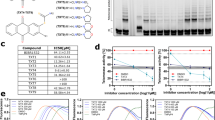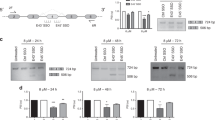Abstract
Bladder cancer is the most common malignant tumor of the urinary tract. Novel treatment approaches are essential because of the failure of current treatment options to cure a high percentage of patients. Telomerase, a ribonucleoprotein, is detected in almost all bladder cancer, but not in normal bladder tissues. Therefore, telomerase is expected to be a very promising candidate for targeted therapy of bladder cancer. In this study, we synthesized a 19-mer antisense oligonucleotide against the RNA component of human telomerase (hTR) linked to a 2–5A molecule (2–5A-anti-hTR) and investigated its antitumor effect against bladder cancer cells. The 2–5A antisense strategy relies on the recruitment and activation of RNase L at the site of targeted RNA sequence. Here we demonstrate that treatment with 2–5A-anti-hTR reduced the viability of seven bladder cancer cell lines (UM-UC-2, UM-UC-3, UM-UC-6, UM-UC-9, UM-UC-14, RT4 and T24) expressing telomerase activity to 21–55% within 4 days. The cytotoxicity was mainly due to induction of caspase-dependent apoptosis. In contrast, normal fibroblast WI38 cells lacking telomerase activity were resistant to the treatment. Furthermore, treatment of subcutaneous UM-UC-2 tumors in nude mice with 2–5A-anti-hTR significantly suppressed the tumor growth through induction of apoptosis (P < 0.001). These findings may offer a strong support to the feasibility of the 2–5A-anti-hTR treatment for human bladder cancer.
This is a preview of subscription content, access via your institution
Access options
Subscribe to this journal
Receive 12 print issues and online access
$259.00 per year
only $21.58 per issue
Buy this article
- Purchase on Springer Link
- Instant access to full article PDF
Prices may be subject to local taxes which are calculated during checkout






Similar content being viewed by others
References
Landis SH, Murray T, Bolden S, Wingo PA . Cancer statistics CA Cancer J Clin 1998 48: 6–29
Lamm DL . Carcinoma in situ Urol Clin North Am 1992 19: 499–508
Utz DC, Hanash KA, Farrow GM . The plight of the patient with carcinoma in situ of the bladder J Urol 1970 103: 160–164
Lamm DL, Griffith JG . Intravesical therapy: does it affect the natural history of bladder cancer? Semin Urol 1992 10: 39–44
Lutzeyer W, Rubben H, Dahm H . Prognostic parameters in superficial bladder cancer: an analysis of 315 cases J Urol 1982 127: 250–252
Skinner DG et al. 25-year experience in the management of invasive bladder cancer by radical cystectomy Eur Urol 1988 33: 25–26
Harley CB et al. Telomerase, cell immortality, and cancer Cold Spring Harb Symp Quant Biol 1995 59: 307–315
Harley CB, Villeponteau B . Telomeres and telomerase in aging and cancer Curr Opin Genet Dev 1995 5: 249–255
Kim NW et al. Specific association of human telomerase activity with immortal cells and cancer Science 1994 266: 2011–2015
Shay JW, Wright WE . Telomerase activity in human cancer Curr Opin Oncol 1996 8: 66–71
Bacchetti S, Counter CM . Telomeres and telomerase in human cancer (review) Int J Oncol 1995 7: 423–432
Liu Y et al. Telomerase activity in human bladder cancer Clin Cancer Res 1996 2: 929–932
Muller M et al. Comparison of human telomerase RNA and telomerase activity in urine for diagnosis of bladder cancer Clin Cancer Res 1998 4: 1949–1954
Kondo S et al. Targeted therapy of human malignant glioma in a mouse model by 2–5A antisense directed against telomerase RNA Oncogene 1998 16: 3323–3330
Mukai S et al. 2–5A antisense telomerase RNA therapy for intra cranial malignant gliomas Cancer Res 2000 60: 4461–4467
Clemens MJ, Williams BR . Inhibition of cell-free protein synthesis by pppA2′p5′A2′p5′A: a novel oligonucleotides synthesized by interferon-treated L cell extracts Cell 1978 13: 565–572
Zhou A, Hassel BA, Silverman RH . Expression cloning of 2-A-dependent RNAase: a uniquely regulated mediator of interferon action Cell 1993 72: 753–765
Torrence PF et al. Targeting RNA for degradation with a (2′-5′) oligoadenylate-antisense chimera Proc Natl Acad Sci USA 1995 90: 1300–1304
Maran A et al. Blokage of NF-kB signaling by selective ablation of an mRNA target by 2–5A antisense chimeras Science 1994 265: 789–792
Cirino NM et al. Targeting RNA decay with 2′, 5′ oligoadenylate-antisense in respiratory syncytial virus-infected cells Proc Natl Acad Sci USA 1997 94: 1937–1942
Kondo S et al. Interleukin-1β-converting enzyme (ICE) mediates cisplatin-induced apoptosis in malignant glioma cells Cancer Res 1995 55: 6166–6171
Koga S et al. A novel telomerase-specific gene therapy: gene transfer of caspase-8 utilizing the human telomerase catalytic subunit gene promoter Hum Gene Ther 2000 11: 1397–1406
Hahn WC et al. Creation of human tumor cells with defined genetic elements Nature 1999 400: 464–468
Hahn WC et al. Inhibition of telomerase limits the growth of human cancer cells Nature Med 1999 5: 1164–1170
Feng J et al. The RNA component of human telomerase Science 1995 269: 1236–1241
Kondo S et al. Antisense telomerase treatment: induction of two distinct pathways, apoptosis and differentiation FASEB J 1998 12: 801–811
Glukhov AI, Zimnik OV, Gordeev SA, Severin SE . Inhibition of telomerase activity of melanoma cells in vitro by antisense oligonucleotides Biochem Biophys Res Commun 1998 248: 368–371
Kanazawa Y et al. Hammerhead ribozyme-mediated inhibition of telomerase activity in extracts of human hepatocellular carcinoma cells Biochem Biophys Res Commun 1996 225: 570–576
Norton JC et al. Inhibition of human telomerase activity by peptide nucleic acids Nature Biotechnol 1996 14: 615–619
Harrington L et al. A mammalian telomerase-associated protein Science 1997 275: 973–977
Nakayama J et al. TLP1: a gene encoding a protein component of mammalian telomerase is a novel member of WD repeats family Cell 1997 88: 875–884
Meyerson M et al. hEST2, the putative human telomerase catalytic subunit gene, is up-regulated in tumor cells and during immortalization Cell 1997 90: 785–795
Nakamura TM et al. Telomerase catalytic subunit homologs from fission yeast and human Science 1997 277: 955–959
Weinrich SL et al. Reconstitution of human telomerase with the template RNA component hTR and the catalytic protein subunit hTR Nat Genet 1997 17: 498–502
Nakayama J et al. Telomerase activation by hTR in human normal fibroblasts and hepatocellular carcinomas Nat Genet 1998 18: 65–68
Zhang X et al. Telomere shortening and apoptosis in telomerase-inhibited human tumor cells Gene Dev 1999 13: 2388–2399
Counter CM et al. Dissociation among in vitro telomerase activity, telomere maintenance, and cellular immortalization Proc Natl Acad Sci USA 1999 96: 3339–3341
Acknowledgements
We thank Dr Robert H Silverman and Dr John K Cowell (Cleveland Clinic, Cleveland, OH, USA) for a gift of 2–5A-anti-hTR. We also thank Dr H Barton Grossman for bladder cancer cell lines. This study was supported in part by Cleveland Clinic Foundation Research Fund No. 5928 (SK).
Author information
Authors and Affiliations
Rights and permissions
About this article
Cite this article
Koga, S., Kondo, Y., Komata, T. et al. Treatment of bladder cancer cells in vitro and in vivo with 2–5A antisense telomerase RNA. Gene Ther 8, 654–658 (2001). https://doi.org/10.1038/sj.gt.3301449
Received:
Accepted:
Published:
Issue Date:
DOI: https://doi.org/10.1038/sj.gt.3301449
Keywords
This article is cited by
-
In vivo evaluation of intravesical paclitaxel and combined bcl-xL antisense oligodeoxynucleotide treatment for orthotopic urothelial carcinoma
Journal of Cancer Research and Clinical Oncology (2009)
-
Telomerase and its potential for therapeutic intervention
British Journal of Pharmacology (2007)
-
Targeting human telomerase for cancer therapeutics
Cytotechnology (2004)



